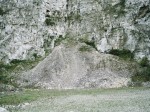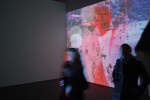May 2012
April 2012
March 2012
February 2012
January 2012
November 2011
October 2011
September 2011
August 2011
July 2011
June 2011
May 2011
April 2011
March 2011
February 2011
December 2010
November 2010
October 2010
September 2010
August 2010
July 2010
May 2010

|
Art Bill Drummond interview
June 6, 2012 The first of 25 final ever interviews with former KLF frontman, writer and artist Bill Drummond. |
During his time as Sensoria Festival’s Composer in Residence in Sheffield last year, artist, musician and writer Bill Drummond built an affinity for the ragworts he found poking their yellow heads between the cracks in the city’s pavement. Like these flowering weeds, he went feral across the city’s wasteland and places of industry. Mapping the chirps of sparrows on an A-Z street atlas and immersing himself in the sounds of steelwork at Forgemasters, he composed a set of scores representing the potential for music in these sites.
In recent years Bill Drummond has been preoccupied with the way we experience, listen to, and consume music in the 21st century. Though there’s something to be said for the transportive power of certain recorded music and the ongoing developments in the craft of creating an artwork in the format of a music album, it’s true that with masses at our fingertips we at times flit about in our consumption of music. Reading one of Bill Drummond’s Scores works, then, by refreshing our relationship to music, making us more aware of our hearing and encouraging us to process the sounds of the spaces around us anew.
The Sheffield Scores are to be performed by The17 – an ever expanding and contracting ensemble consisting of whoever is chosen or chooses to read them. They were recently showcased in the ‘Ragworts’ exhibition, which opened at Site Gallery in the city on the eve of this year’s Sensoria.
We interviewed Bill, in accordance to this set of rules he’s imposed on himself.

1: During your time as Composer in Residence in Sheffield in April 2011 you composed scores specific to certain sites, times, and people. They may be performed actually, by individuals/groups in the situations you specify, or entirely conceptually. You may not even know if some are ever performed at all. Score #390: Seventeen Deep Breaths plays out joyfully in my imagination each time I read it (despite not having sought permission from a man called Honeyman). Can such imagined performance be as fulfilling as people being brought together and conducted in a physically audible event?
I think I wanted my cake and to eat it. For me, if these scores have any real strength it is to be had by coming across them accidentally where they are hung or fly posted in their various locations around Sheffield. I like the idea of people coming across them and not really knowing what they are or what they fit into and I definitely did not want to have an author/composer name attached to them, in case the person who does the coming across them knows something about me and automatically reads them in the context of my history. And these people that come across them would actually perform the score.
But I guess that is partially fantasy. If the above was really true, would I have spent the time I did in working on the wording, would I have put them up on The17 website, would I be just about to have them hanging in a exhibition in the Site Gallery, Sheffield? Thus I must have wanted the applause of a wider audience. But that is not quite what your question is about. You are asking me about them being performed conceptually. And the honest answer to that is I never imagined that to be the case. When I finally got around to reading all the scores in Yoko Ono’s book Grapefruit a few years back, I read all her scores in the book as conceptual. That is what they are supposed to be, that was their strength. But for me, I have always wanted the scores that I have written for The17 to be something that can be engaged with in a practical sense. I want what I write to be clear instructions as to how to make the performance actually happen, even if it can only be performed by a select group of people. And some of the scores that I did in Sheffield, by their very nature could only ever be performed by a very few select people.
As for Score 390: SEVENTEEN DEEP BREATHS, I wrote that wanting Graham Honeyman, the boss of Forgemasters, to perform it. While working there I learnt from him that he was a jazz fan and played the saxophone. I do not know if he ever will perform it, but I was very grateful to him for giving me the access to Forgemasters to evolve these scores and to allow them to be then hung permanently in various locations in the works.

2: In the accompanying book to your upcoming exhibition Ragworts you say you prefer degeneration to regeneration and that you find beauty in redundancy. What is the appeal of these to you and in what ways can they actually facilitate creative progression?
I am aware that in making a statement like this, there is probably an element of pose. None of us want to live in a building with a hole in the roof. But the part that is not pose may be born from the following facts. I spent my teenage years living a town called Corby, Northamptonshire. As well as it being a steel town and known as little Scotland, it was also a new town. Of the population of 55,000 the vast majority of us were living in post war council housing. All the roads were neatly planned. It was the 60s and Corby was a boomtown. Everything was new and sparking. The vast majority of the population had come from the crumbling Victorian tenements of Glasgow and other West of Scotland towns. Corby was so much better than what most of us had left behind.
Then in 1972, at the age of 19, I moved to Liverpool to go to the art school there. I was embarking on a fine art course. I was in love with painting. I wanted to dedicate the rest of my life to painting. But nothing I could do on my canvas in the art school could compete with what was already out there in Liverpool itself. I was totally seduced by the city. And at that time the city was a complete wasteland. It was terraces of 19th century housing, much of it being ripped down. And then there were the docks, all just falling to bits. A few years earlier there may have been ships arriving laden with the treasures of our then Empire. But by the 1970s next to nothing. Instead of putting in the hours infront of my easel struggling with the paint, I would spend hours and days and weeks, just wandering around this city that was degenerating. It was this degeneration that fired me to do whatever I did there back in the 70s and early 80s.
As much as I know cities need to be regenerated, to create work and wealth for the majority of the population, I find it very hard to feel enthusiastic about much of what does go up. Especially when it is buildings that you know have already been given a limited shelf life of no more than 25 years.
3: Ten years ago a well-known musician predicted that by 2012 music would have ‘become like running water or electricity’. Thankfully we do not receive flat rate utility bills for our consumption of music, but could we be seen as wasting it in a similar way as we do water or electricity and, if so, should any conservation measures be taken?
Both question 3 and 4 deal with topics that I have explored extensively over that past few years. I will attempt to bring something to my answers that I have not already said before. The flat rate utility bill is basically how we already do pay for so much of the recorded music we consume be it via Spotify or YouTube and I am sure it is only a matter of time before Amazon will be making the same sort of offers as they do with Love Film.
As for a hosepipe ban on recorded music. I would be all for it. In a way the No Music Day that I instigated on each 21 November between 2005 – 2009 was a sort of hosepipe ban. These days I have a complete hosepipe ban on recorded music in my home.
4: It was around 150 years ago that humans developed technology to record music. Can you dream up a utopian vision of the state of music and how we may consume and interact with it in another 150 years time? (Please be as conjectural or as sci-fi as you wish…).
I have made the claim that recorded music was an art form of the 20th century. Although the technology to record music is 150 years old, the first commercially released recorded music came out in 1901. Caruso was the first super star of this new art form. Throughout the 20th century all previous forms of music wanted to become recorded music. The music industry grew and grew to exploit this. In the second half of the 20th century recorded music was the only art form that could rival its close cousin the Movies. But in the closing decade of the century with Napster, followed by iTunes our relationship with recorded music shifted hugely. The life of an art form follows a predictable arc. That said some almost die overnight like the silent movies did in 1927, with the release of The Jazz Singer, the first talkie. Other art forms spend centuries slowly dying. Recorded music will not die out over night but its central importance to our culture is already beginning to diminish.
As for music in 150 years time, people will still want to dance, fall in love, protest, laugh out loud and make their innermost feelings public and music will be a big part of all that. And sadly people will still want icons, it is a human weakness. If you had asked me five years ago I would have said musicians, as icons were definitely a product of the 20th century. I was on record with saying that there would be no more global stars of the cultural importance of Elvis, The Beatles, Michel Jackson or Madonna but then along came Lady Gaga and I fell for her along with several million others. She demonstrated that there was a lot more gold to be mined from that particular seam.
Lady Gaga aside, I predict the strait jacket that recorded music held us in for much of the previous century will never be able to hold us down as mere consumers again. Now that we are being freed from it, we will want music that is about time, place and occasion. This will undoubtedly make use of whatever technology we have at the time, but it will also very much include the vast majority of us recapturing our ability to open our own mouths and make music with what comes out of them together. We will never let that sense of freedom that can be achieved with singing together ever be stolen from us again.

Kathryn Hall
-
This interview is published in Article’s Broken issue. To read the whole magazine, you can order it here or find a copy in one of our stockists.







